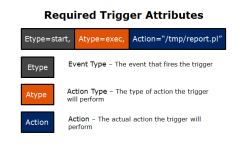17.1 Creating a trigger
Three methods exist for attaching a trigger to an object:
- Directly to the object via the command line
- Directly to the object via the configuration file
- As part of a template via the configuration file
<attr>=<val> pair delimiters, quotation marks, and other elements of the syntax may differ slightly from one method/object combination to another, but creating any trigger follows the same basic format:
<attr>=<val>[[{&,}<attr>=<val>]...]
The beginning of the trigger is set off by the keyword trigger. It is followed by a delimited list (typically by commas) of <attr>=<val> pairs.
Each method of trigger creation can only be used for certain Moab objects. The following table displays which objects can receive triggers via each method. The links contain examples.
| Method | Objects |
|---|---|
| Command line | job, reservation; a trigger can be attached to any existing object using mschedctl -c |
| Configuration file | node, reservation, RM, scheduler |
| Template | job, reservation |
Triggers are composed of attributes. Only three are required for each trigger: an EType (event type), an AType (action type), and an Action.
|
Image 17-2: Required trigger attributes |

|
|
Click to enlarge |
Other attributes exist to further customize triggers. See Trigger components for more information.
To create a Moab trigger
-
Choose an object to which, and a method by which, you will attach the trigger. Use the format and examples described in its corresponding documentation:
- Decide whether to attach the trigger via the command line or configuration file. Verify the correct syntax.
- Set the EType equal to whichever event will launch the trigger if and when it occurs on the object.
Each object has a different lifecycle, so not every event type will occur on every object. For a list of valid ETypes for your selected object, see the corresponding object reference page linked in step 1.
- To modify the timing of the trigger in any of the following ways, see Event-modifying trigger components.
- To set the trigger as rearmable and specify the amount of time the trigger must wait before firing again.
- To set an amount of time before or after the event that the trigger will fire (See Offset for restrictions).
- To set a specific threshold and the amount of time that the object must meet that threshold before the trigger will fire.
- To modify the timing of the trigger in any of the following ways, see Event-modifying trigger components.
- Configure the action that the trigger will take when the event happens. To do so, you must set the AType to a valid value for your object and specify the action. For instance, to execute a script, set the AType to exec and the Action to the location of the script in quotation marks. Include the name of the object on which the script will run.
- To modify the action in any of the following ways, see Action-modifying trigger components.
- To specify environment variables available to the trigger
- To set a flag on the trigger
- To attach any stderr output generated by the trigger to the parent object
- To destroy the trigger if its object ends or cancels
- To tell Moab to checkpoint the trigger
- To set the trigger as periodic
- To pass the object's XML information to the trigger's stdin
- To set the trigger to reset if its object is modified
- To set the trigger to fire under the user ID of the object's owner
- To specify an amount of time that Moab will suspend normal operation to wait for the trigger to execute
- To allot an amount of time that the trigger will attempt to run before it is marked as unsuccessful and the process, if any exists, is killed
- Set a maximum number of times that a trigger will attempt to fire before it fails
- To give the trigger a name or description, see Organizational trigger components.
- To configure the trigger to set or unset a variable when it fires or to require a variable to fire, see Setting and receiving trigger variables.
If the trigger is to be attached to a job, you must first enable job triggers (see Enabling job triggers for more information.). Please carefully review the warning before doing so.
NODECFG[node01] TRIGGER=EType=fail,AType=exec,Action="node.fail.sh node01"